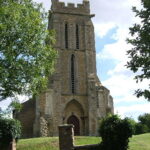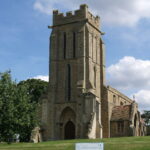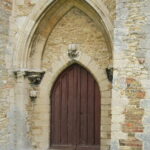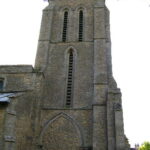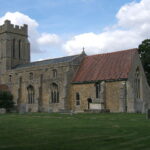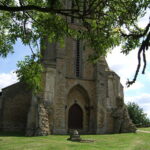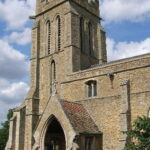Church of the Holy Cross Bury
The Church of the Holy Cross Bury is built of rubble with Barnack stone dressings and the roofs are covered with slates and tiles.
The plan of the Church shows, a chancel ( 27ft by 14.5ft ), nave ( 48ft by 19.5ft ), north aisle ( 7.5ft wide ), west tower ( 11ft by 10ft ), and formerly a western chapel (about 45ft 21.5ft)
The early 12th-century church which stood here probably only consisted of a chancel and nave; the east and west walls of the nave of this church still survive. Early in the13th-century the north aisle with it’s nave arcade was added and in the middle of the same century the western tower was built. In the 14th-century considerable alterations were made, firstly the north wall of the north aisle was rebuilt, maybe because of foundation problems. Then the chancel and south wall of the nave were rebuilt and new windows were inserted in the north aisle.
Towards the end of the 15th century, the large chapel west of the tower was built, possibly as a Lady Chapel. The chancel was shortened by about 13ft in the 16th century, which can be seen by the remains of the two windows at the eastern angles of the church. The porch was built and the church restored in 1889.
For generations pilgrims on their way to and from the shrines at Ramsey Abbey, would stop and admire the treasures at this church, why? Because Bury Church kept a treasured image of the Virgin Mary, and to this image they would pray. Gifts would also be left at the altar out of gratitude and love.
These gifts and offerings were worth a considerable amount of money, a list made in 1508, when William Eryth, the Ramsey Abbey almoner, wrote that £17 0s 6p had been given back to Bury Church, showed a number of black jet beads, silver and gilt, fine silk, amber, crystal, pearls, a pendant and chain of silver and gold, silver and gilt rings were put on the Virgin’s fingers, there was mother of pearl and chains of purest gold!
It is recorded that the value of these offerings did not entirely benefit the village church, most of the revenue stayed in the coffers of Ramsey Abbey.

